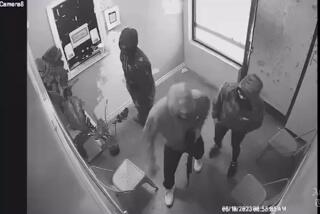A bit of digging unearths tales of L.A. bootlegging, crooked cops
I was drinking at King Eddy’s, the skid row dive that’s being made over into a hipster bar, when I overheard people say that a web of old bootlegger tunnels lay under downtown.
A labyrinth, running from the old speakeasy beneath King Eddy’s to Pershing Square and points beyond — even San Pedro? They had me at “tunnel.” I had to know more.
The Los Angeles Department of Public Works didn’t know about the tunnels. Map librarian Glen Creason of the Central Library told me that they were never mapped, for obvious reasons. I had hit a wall.
But the tunnels led me to rivers of Scotch and oceans, the real story of how illicit liquor came into Los Angeles during the dry decade. Bootlegging was run out of City Hall, with the blessings of crooked cops and prosecutors. Sure, there were tunnels. But they were just a sideshow.
“The only people doing tunnels were not connected,” Los Angeles County Sheriff’s Deputy Michael Fratantoni told me. If you were one of the insider crooks, “you could bring it out in the middle of the street. It didn’t matter.”
Fratantoni is from a law enforcement family in Long Island, N.Y. He arrived in Los Angeles and was astounded by the paltry store of local crime lore, beyond oft-told tropes like the Black Dahlia and Manson murders.
He tracked down department old-timers, crime beat reporters and their widows and children, and pulled boxes of investigative reports and photographs from basements and garages. A board member at the Los Angeles County Sheriff’s Museum in Whittier, he has pieced together a nasty picture of Prohibition-era corruption.
Guy McAfee, the head of the LAPD vice detail (“the Purity Squad”), ran gambling joints on the side and then quit to become a bootlegger, Fratantoni said. Mob boss Charles Crawford, who boasted of a private telephone line into City Hall, was shot to death by a former assistant district attorney who was running for judge.
The king of the Southern California rum runners was Tony Cornero, an Italian immigrant who had his own fleet of ships that brought the high-end stuff down from Canada. The contraband was unloaded in the moonlight on beaches, then trucked to wealthy clubs with complete impunity, Fratantoni said.
“City politicians and police were running everything in the city limits,” Fratantoni said. “Not only did they have a hand in it, they were making the decisions.”
Liquor raids were largely for show. The guys who got hit were mainly outside L.A., in places like Downey and Newhall, where some made “grape-o” moonshine that “would burn a hole in your throat,” Fratantoni said.
Deputies spied from blimps to spot telltale exhaust pipes sticking out of the fields. A beautiful undercover agent named Maria Valdez infiltrated bootlegging rings for the sheriff’s liquor detail.
Over dinner, Fratantoni showed me old photographs of a bootlegging storage tunnel beneath a barn in Newhall and a still with a triple-ringed stovepipe. Real Hatfields & McCoys stuff. “Kind of like the meth labs of today,” Fratantoni said.
After a brief stint in federal prison for bootlegging, Cornero returned to Southern California in 1938 and anchored luxury gambling ships in international waters in Santa Monica Bay. Customers were ferried out to the boats from the Santa Monica and Redondo Beach piers in water taxis.
Creason, the librarian, said his dad was a craps dealer on one of Cornero’s floating gambling dens.
“My father always said the first honest police chief wasn’t appointed until the 1950s,” Creason said.
The best record of Los Angeles sleaze, however, is found in fiction. I had always thought crooked “Bay City” cops and floating dice boats were Los Angeles detective novelist Raymond Chandler’s greatest literary inventions. Now, come to find they are pure reportage.
From Chandler’s “Farewell, My Lovely”: “The Royal Crown seemed to ride as steady as a pier on its four hawsers. Its landing stage was lit up like a theater marquee.... There was light on the Montecito also and music floated across the wet dark sea. The spooning couples took their teeth out of each other’s necks and stared at the ship and giggled.”
Cornero was shot in the stomach at his Beverly Hills home in 1948. A perfectly absurd article in the L.A. Times at the time said the shooting of the “last of the big-time underworld czars” took place while he was discussing “business” with a Mexican “commodities broker” and an attorney.
Cornero survived the attack and died in 1955 before his magnum opus, the $6-million Stardust hotel and casino in Las Vegas, could open. The cause of death was either:
1. A heart attack he suffered during a game of craps in the middle of a Vegas casino, or
2. A stealthy injection of an unknown substance by gangland rivals who kept Cornero’s body in a hotel suite for four hours before allowing the coroner to examine it.
Common sense tells us the most likely explanation is usually the simplest. The truth is buried as deeply as the tunnels. But in this case, I’ll take the sordid interpretation.
“Los Angeles just gives itself a face lift,” Fratantoni said. “It’s the same old face under there.”
More to Read
Sign up for Essential California
The most important California stories and recommendations in your inbox every morning.
You may occasionally receive promotional content from the Los Angeles Times.










